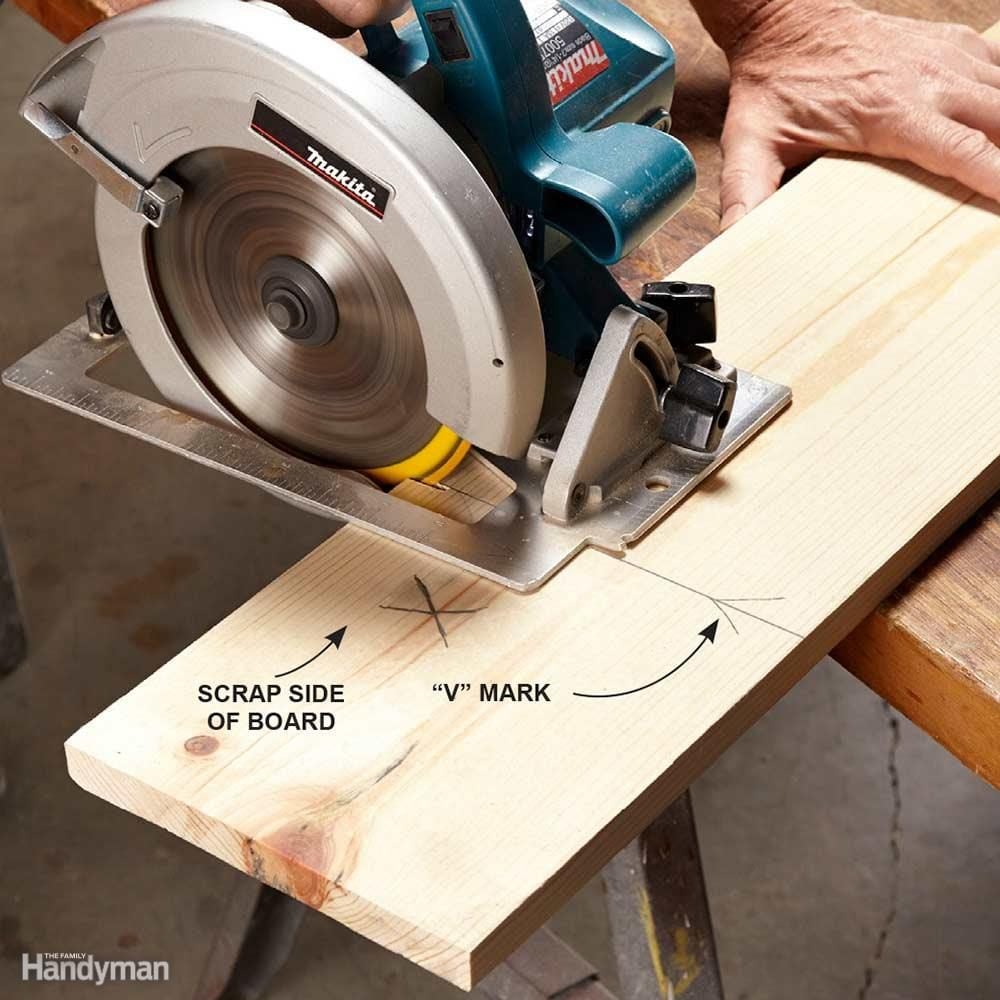Are you curious about what you can do with a circular saw? Well, let’s dive right in and explore the endless possibilities! Whether you’re a DIY enthusiast or a budding carpenter, a circular saw is a versatile tool that can help you tackle a wide range of projects. From cutting lumber for home renovations to crafting intricate designs for your woodworking projects, this power tool is a game-changer.
With a circular saw, you can build your own bookshelf, construct a sturdy workbench, or even create custom picture frames. The possibilities are limited only by your imagination. This tool’s ability to make precise and straight cuts makes it ideal for various materials like wood, plastic, and metal. Its portability and ease of use also make it a popular choice among enthusiasts who are always on the go.
Not only can a circular saw help you bring your creative ideas to life, but it can also save you time and money. Instead of relying on pre-cut materials or hiring professionals, you can take matters into your own hands and complete projects at your own pace. So, if you’re ready to unleash your inner craftsman and explore the world of DIY, let’s get started with the incredible possibilities of a circular saw!
1. Cutting Plywood: Use the circular saw to make clean and precise cuts on plywood sheets.
2. Ripping Boards: Easily rip boards to your desired width using a straight edge guide.
3. Trimming Doors: Trim doors for a perfect fit by cutting off excess material with a circular saw.
4. Building Shelves: Create custom shelves by cutting boards to size with a circular saw.
5. Making Furniture: Build furniture pieces like tables and cabinets by cutting and shaping wood with a circular saw.
With its cutting power and flexibility, a circular saw is a must-have tool for any DIY enthusiast or professional carpenter.

What Can I Do with a Circular Saw? A Comprehensive Guide
Welcome to our comprehensive guide on what you can do with a circular saw. Whether you’re a DIY enthusiast or a professional carpenter, a circular saw is an essential tool in your arsenal. Its versatility and power make it suitable for various cutting tasks, from ripping lumber to making precise crosscuts. In this guide, we will explore the multitude of applications for a circular saw and provide you with tips and techniques to maximize its potential. So, let’s dive in and discover the endless possibilities that a circular saw brings to the table!
Unlocking the Potential: What Can You Do with a Circular Saw?
A circular saw is a powerhouse when it comes to woodworking and construction projects. With the right techniques and accessories, you can accomplish a wide range of tasks efficiently and precisely. Here are three key areas where a circular saw shines:
Cutting Plywood and Lumber
One of the primary uses of a circular saw is cutting plywood and lumber. Whether you’re constructing furniture, building a deck, or tackling a home renovation project, a circular saw makes quick work of these materials. With its adjustable depth and bevel settings, you can achieve accurate and clean cuts on both straight lines and angled edges. By using a straightedge guide or a cutting jig, you can ensure straight and parallel cuts, allowing for seamless assembly of your projects.
When cutting plywood, it’s important to choose the right blade with a high tooth count to prevent splintering. For cutting lumber, a general-purpose combination blade or a rip blade is ideal. Don’t forget to measure and mark your cuts before starting, and always wear safety goggles and hearing protection for a safe and enjoyable woodworking experience.
Creating Crosscuts and Miters
A circular saw equipped with a miter gauge or a bevel guide is invaluable for creating crosscuts and miters. Whether you need to trim trim work, cut baseboards, or create picture frames, a circular saw allows you to make precise angled cuts quickly. The adjustable angles on the circular saw’s bevel and miter scales enable you to achieve custom angles effortlessly, enhancing the versatility of your projects.
To ensure accurate and clean cuts, make sure to secure your workpiece firmly and use clamps or a workbench. Additionally, using a fine-toothed crosscut blade will give you cleaner results. Take your time and practice on scrap pieces before tackling your actual project to build confidence and improve your skills.
Ripping Wood Boards
When it comes to ripping wood boards, a circular saw with a rip fence attachment ensures precise cuts along the length of the material. Whether you need to create narrow strips for edging or cut a piece of lumber into smaller dimensions, a circular saw is the tool for the job. By adjusting the rip fence to the desired width, you can guide the saw along the edge of the material, resulting in straight and consistent cuts.
Before starting, apply painter’s tape along the cutline to minimize tear-out. Remember to feed the material slowly and steadily to prevent kickback and keep your fingers away from the blade. With the right technique and a sharp ripping blade, you can achieve professional-looking results in no time.
Additional Techniques and Tips for Working with a Circular Saw
Now that we’ve covered the main applications of a circular saw, let’s explore a few additional techniques and tips to enhance your woodworking experience:
Using a Track Saw System
If you frequently work with large sheets of plywood or want to achieve even more precise cuts, consider investing in a track saw system. This system consists of a circular saw that rides on a track, providing increased stability and accuracy. The track ensures straight cuts without the need for clamps or straightedge guides, making it an excellent addition to your circular saw setup.
Safety First
Working with power tools, including a circular saw, requires taking appropriate safety precautions. Always wear safety goggles, ear protection, and a dust mask to protect yourself from flying debris and potentially harmful dust particles. Additionally, keep your work area clean and well-lit, and disconnect the saw from the power source when not in use. Following these simple safety measures will help ensure a safe and enjoyable woodworking experience.
Choosing the Right Blade
The type of blade you use greatly impacts the quality of your cuts. For general-purpose cuts, a combination blade with a high tooth count will suffice. However, for specialized tasks like fine crosscuts or ripping, consider investing in blades specific to those applications. Additionally, make sure to keep your blades sharp and clean for optimal performance and longevity.
In Summary
A circular saw is a versatile and indispensable tool that opens up a world of possibilities for DIYers and professionals alike. From cutting plywood and lumber to creating precise crosscuts and ripping wood boards, a circular saw empowers you to tackle various projects with ease. By following the right techniques, ensuring safety, and selecting the appropriate accessories, you can unleash the full potential of your circular saw and achieve outstanding results. So, grab your circular saw and let your creativity flourish!
Key Takeaways: What Can I Do with a Circular Saw?
- You can use a circular saw to make straight cuts in wood and other materials.
- With the right blade, you can cut through plywood, MDF, and even hardwood.
- A circular saw can be used for making angled cuts, bevel cuts, and rips.
- It’s a versatile tool that is commonly used in carpentry, woodworking, and DIY projects.
- Always wear safety goggles and follow the manufacturer’s instructions when using a circular saw.
Frequently Asked Questions
Welcome to our FAQ section on what you can do with a circular saw! If you’re wondering about the possibilities and potential of this versatile tool, you’ve come to the right place. Below, we’ve answered five common questions that shed light on the many tasks you can accomplish with a circular saw. So let’s get cutting!
1. What are some basic cuts I can make with a circular saw?
With a circular saw, you can make a variety of basic cuts for different woodworking projects. These include straight cuts, crosscuts, rip cuts, bevel cuts, and miter cuts. Straight cuts are the most common, giving you a straight line across a piece of wood. Crosscuts help you cut across the grain, while rip cuts go along the grain. Bevel cuts allow you to create angled edges, and miter cuts are perfect for making precision angles.
By mastering these basic cuts with your circular saw, you’ll have the foundation to tackle a wide range of woodworking projects, from building shelves and tables to constructing wooden frames and more.
2. Can I use a circular saw to cut materials other than wood?
Absolutely! While a circular saw is commonly used for woodworking, it can also handle various other materials. With the right blade, you can cut through materials like plastic, metal, laminate, and even concrete. Just ensure that you select the appropriate blade for the material you’re working with, as different blades are designed for specific materials.
Whether you’re looking to make precise cuts on metal sheets or create clean edges on plastic materials, a circular saw can be a valuable tool for a wide range of projects. Make sure to follow safety precautions and adjust your technique accordingly when cutting different materials.
3. What safety precautions should I take when using a circular saw?
When working with a circular saw, it’s essential to prioritize safety. Here are a few precautions to keep in mind:
Firstly, always wear protective gear, including safety glasses, ear protection, and gloves. It’s also crucial to secure your workpiece with clamps or a vice to prevent movement while cutting. Additionally, make sure you have a clear line of sight to the cut, and keep your hands at a safe distance from the blade. Remember to follow the manufacturer’s instructions for your specific circular saw model and keep the blade guard in place whenever possible. Lastly, always unplug the saw when changing the blade or making adjustments.
4. Can a circular saw be used for precise and intricate cuts?
While a circular saw is not typically known for making intricate or detailed cuts, it is still possible to achieve precision with the right techniques and accessories. One option is to use a guide or fence to ensure straight and accurate cuts. Additionally, you can use a smaller blade with more teeth for finer cuts or invest in a track saw system designed for increased precision.
Remember, practice makes perfect. Take the time to familiarize yourself with your circular saw and experiment with different cutting techniques to improve your precision over time.
5. Are there any maintenance tips to keep my circular saw in good shape?
To keep your circular saw performing at its best, regular maintenance is key. Here are a few tips to maintain your tool:
Firstly, keep the blade clean and free from pitch or debris. After each use, give it a quick wipe down with a clean cloth. Additionally, regularly check the blade for any signs of damage or dullness, and replace it when necessary. Keep the saw’s base plate clean and lubricated to ensure smooth cuts. Lastly, inspect the saw’s power cord and the integrity of its components, such as the blade guard and safety features, to ensure everything is in proper working order.
By following these maintenance practices, you can extend the lifespan of your circular saw and ensure reliable performance for years to come.

Summary
So, now you know what you can do with a circular saw! With this handy tool, you can make straight and angled cuts in various materials like wood or metal. Whether you want to build furniture, do home improvements, or tackle DIY projects, a circular saw is a versatile tool to have in your toolbox. Remember to always wear protective gear and follow safety guidelines when using it. So, grab your circular saw and start creating amazing things!
